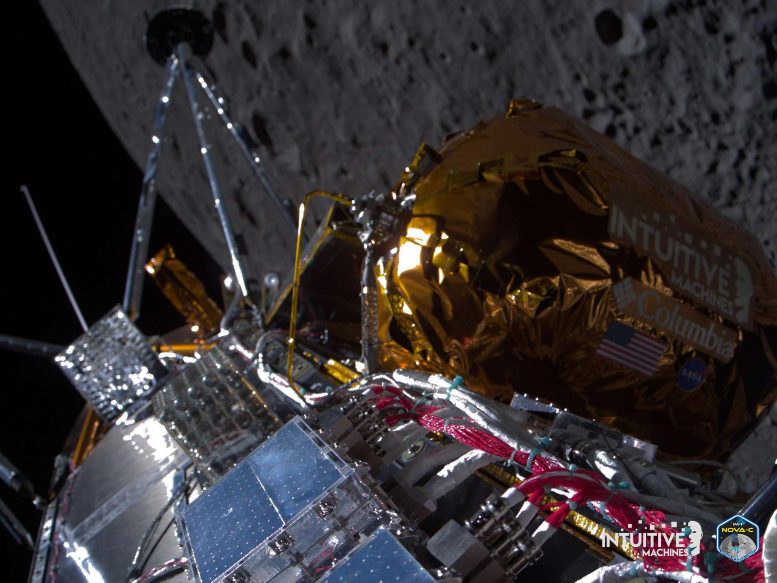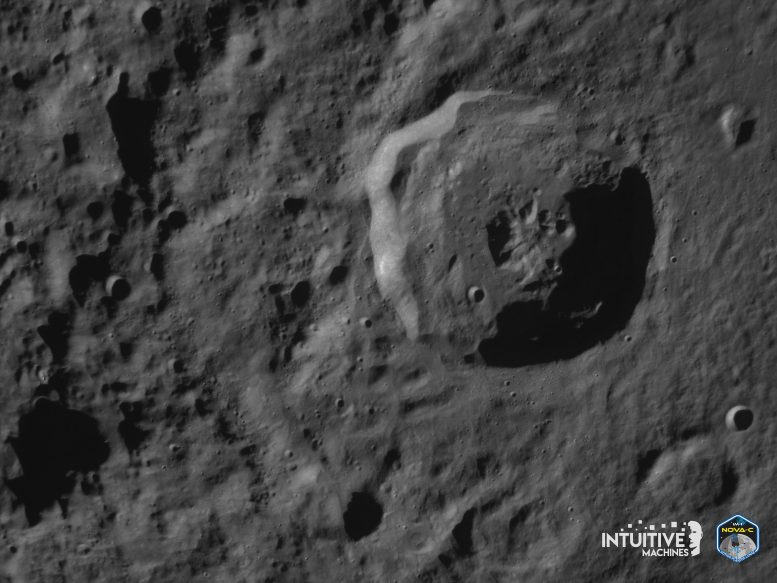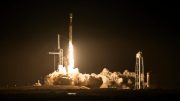
Odysseus passes over the near side of the Moon after entering lunar orbit insertion on February 21. Credit: Intuitive Machines
Intuitive Machines’ Odysseus lander has achieved lunar orbit, with all systems operational and ready for a targeted lunar landing.
Intuitive Machines’ Odysseus lander has completed lunar orbit insertion successfully and is currently orbiting the Moon. Odysseus continues to be in excellent health and is approximately 60 miles (92 km) from the Moon.
Countdown to Lunar Landing
The spacecraft will orbit the Moon for approximately one day before beginning its descent toward the lunar surface. The landing opportunity is targeted for Thursday, February 22, at 5:30 p.m. EST.

Odysseus’ Terrain Relative Navigation camera captures the Bel’kovich K crater on the Moon’s northern equatorial highlands. The crater has an approximate 50 km diameter with mountains in the center, made when the crater was formed. Credit: Intuitive Machines
Instrument Checkouts and Operations
All powered NASA science instruments on board have completed their transit checkouts, received data, and are operating as expected, including: LN-1 (Lunar Node 1 Navigation Demonstrator), NDL (Navigation Doppler Lidar for Precise Velocity and Range Sensing), RFMG (Radio Frequency Mass Gauge), ROLSES (Radio-wave Observations at the Lunar Surface of the Photoelectron Sheath), SCALPSS (Stereo Cameras for Lunar Plume-Surface Studies). Since the LRA (Laser Retroreflector Array) instrument is a passive experiment designed for the lunar surface, it cannot conduct any operations in transit.
Communications and Health Checks
LN-1 has made three successful passes with NASA’s Deep Space Network, establishing real-time communications with ground stations on Earth. Upon lunar touchdown, the LN-1 team will conduct a full systems checkout and begin continuous operations within 24 hours of landing. NASA’s Deep Space Network will receive its transmissions, capturing telemetry, Doppler tracking, and other data and relaying it back to Earth.
A SCALPSS checkout was completed during transit, confirming the cameras are operating as expected and the instrument is in good health. Using four tiny cameras, SCALPSS will collect imagery of how the surface changes from interactions with the spacecraft’s engine plume as the lander descends toward the Moon.
Preparing for Lunar Landing
RFMG continues to gauge the cryogenic propellants on Odysseus throughout the mission, including propellant loading, transit, lunar orbit insertion burn, and low lunar orbit. Data collection and analysis will continue through landing on the Moon and could provide insights on how to measure fuel in microgravity.
NDL and ROLSES have been operated, and flight controllers will continue to monitor the instruments and collect data to inform preparations for landing.
Intuitive Machines’ IM-1 mission is the company’s first mission through the agency’s Commercial Lunar Payload Services initiative, which aims to gain new insights into the lunar environment and expand the lunar economy to support future crewed missions under NASA’s Artemis campaign.









I heard it landed?